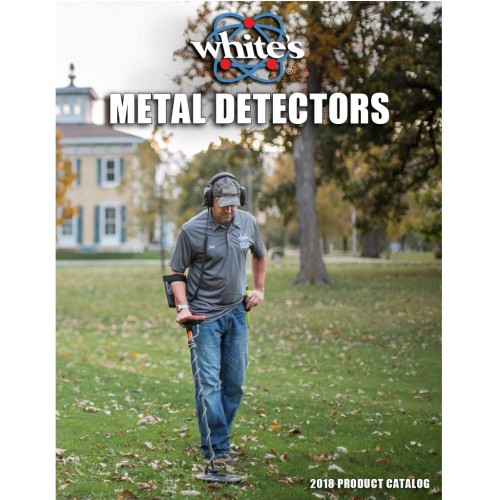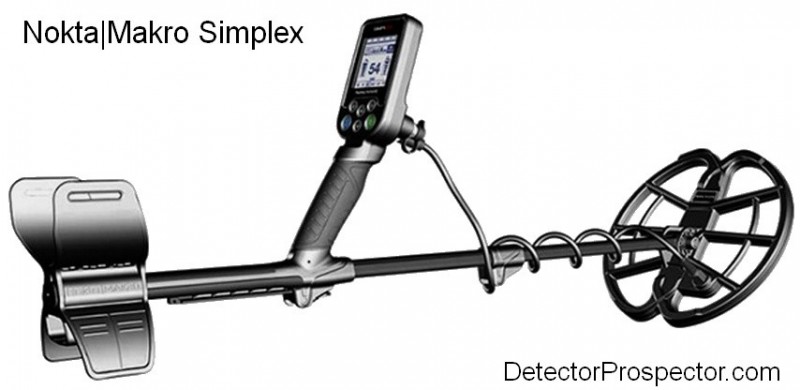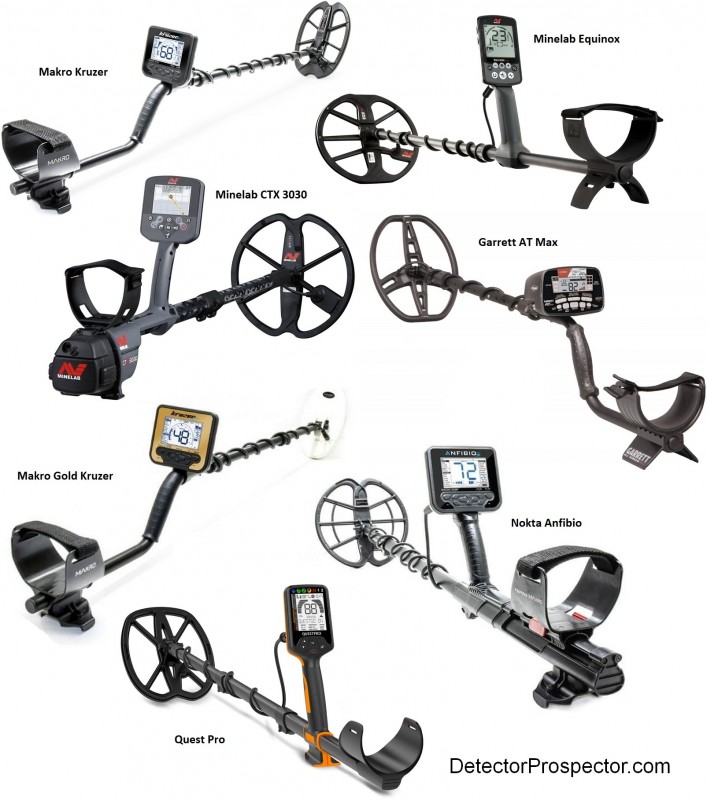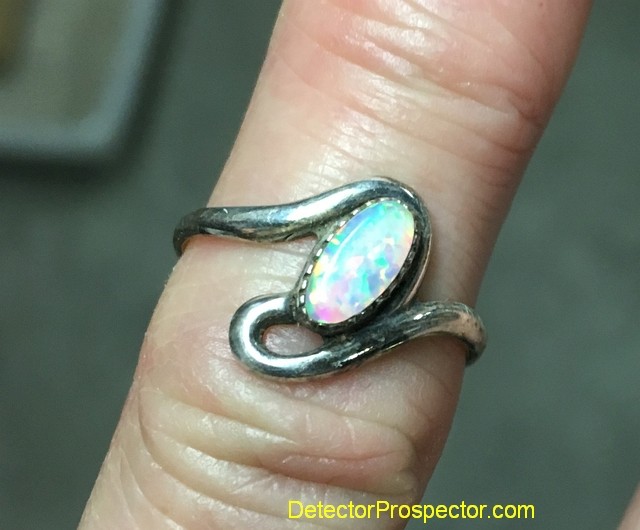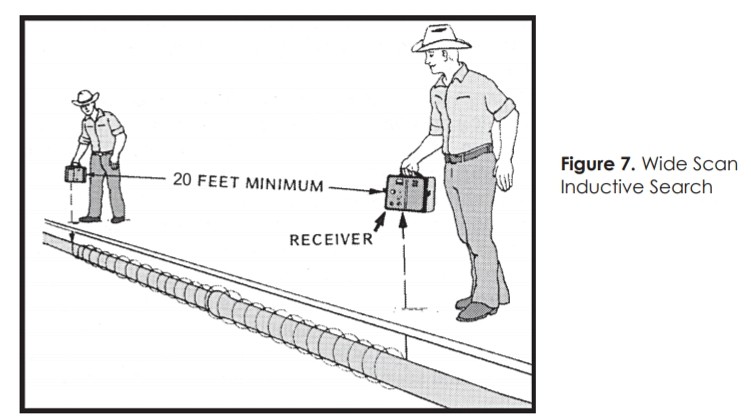-
Posts
19,790 -
Joined
Content Type
Forums
Detector Prospector Home
Detector Database
Downloads
Everything posted by Steve Herschbach
-

White's 2018 Metal Detector Catalog
Steve Herschbach commented on Steve Herschbach's file in White's Electronics
-
The White's TDI BeachHunter metal detector was introduced in 2018 and is still in was still in production when White’s closed up shop in 2020. The TDI BeachHunter is a fully submersible pulse induction (PI) metal detector aimed primarily at beach detecting for coins and jewelry. The TDI BeachHunter is basically a waterproof TDI SL and performance is about the same. "Common VLF detectors, even multi-frequency ones, can struggle in strong mineralization or salt conditions. That’s where the power of Pulse Induction can help you find more treasure! Specially-built for both the beach and the goldfields, the TDI BeachHunter offers extreme depth performance on land or sea. Waterproof to 25 ft, the TDI BeachHunter punches deep at the beach, in goldfields, or even in difficult relic areas like red clay. The adjustable Pulse Delay lets you set the machine up for maximum sensitivity to fine gold jewelry, small nuggets, and hammered coins at depth. Just set your ground balance, adjust your gain, and start swinging! With the dual-tone audio users quickly learn the difference in sounds, and adjustable volume and threshold controls allow flexibility for different hunters’ preferences. At only 5.2 lbs, the TDI BeachHunter is ready for action, and an included hip and chest-mount pouch allows for users to customize the machine to their own hunting style. The included Heavy-Duty NiMH rechargeable battery extends the run-time to about 6 hrs, and the backup 8 AA battery pack means you’re setup for long days in search of gold, silver, or relics. The patented 12″ Dual-Field search coil features two coils in one – a small, inner coil with higher sensitivity to small targets, and larger outer ring that punches deep into salt or other mineralization. Due to the fact that the coil is hard-wired, users may find this model offers increases sensitivity and stability compared to the TDI SL." Source: White's website White's TDI BeachHunter metal detector White's TDI BeachHunter control panel FULLY SUBMERSIBLE UP TO 25 FEET FULL-CONTROL GROUND BALANCE - Quickly balance out the iron mineralization of hot rocks, black sand and other tough grounds ADJUSTABLE PULSE DELAY - Settings from 10 microseconds (best for finding gold nuggets) to 25 microseconds (for relic, coin and beach hunting) THRESHOLD CONTROL - Accurately adjust the audio to hear the smaller, deeper signals FREQUENCY CONTROL - Adjustable for hunting near power lines, microwave or other interference GAIN CONTROL - Maximizes sensitivity and depth LOW BATTERY L.E.D. INDICATOR LIGHT NIMH RECHARGEABLE BATTERY PACK - Up to 6 hours of hunting. Backup “AA” pack included. WATERPROOF 12” SPIDER search coil TWO-YEAR Parts and Labor Warranty Official White's TDI BeachHunter Product Page White's TDI BeachHunter Owner's Manual White's TDI BeachHunter Color Flyer White's Metal Detector Forum
-
-

Is The Simplex Detector Release Near ?
Steve Herschbach replied to a topic in Nokta / Makro Metal Detectors
Looks like a nice unit, similar to Quest and Equinox in appearance. Nokta|Makro Simplex metal detector -

2019 - A Look Ahead
Steve Herschbach replied to Steve Herschbach's topic in Metal Detector Advice & Comparisons
Thanks JP for making that comment. I feel the same way and rather than embrace social media I decided to flee it. I just want to put out good information that is helpful to others. I have worked hard at trying to improve and organize the website (not just forum) into an informational archive. My main effort will be in boosting the metal detector database and in general trying to make the website the place where an answer can be found on almost any detecting subject. The forum itself I expanded greatly in the last year and have done everything possible to create a place for people to share useful information. At this point it will simply either grow or slowly die. How that goes depends almost entirely on the members and their willingness to help others. Anything you contribute JP will be appreciated by many I am sure - thanks in advance! ? -
Happy New Year! It has been a couple years of furious activity in a normally slow moving industry. We are in a Golden Age of detector hardware, with intense competition driving prices lower while fostering innovative new designs. Most of the action has been from manufacturers outside the U.S. - will 2019 be the year U.S. manufacturers strike back? It will be interesting but rumors are thin on the ground right now. New models appearing are niche models, like the new XP ORX, aimed at the gold prospectors. A new manufacturer has appeared, Tarsacci, with the new MDT 8000 that initially anyway seems to be aimed at beach hunters. The machine I most have my eye on is the upcoming Fisher Impulse AQ. I am satisfied with what VLF technology exists now, so all I need is a PI detector at least as powerful as a Garrett ATX in a housing weighing under 5 lbs. I sold my ATX and currently do not have a PI and am waiting on what Fisher has to show before deciding what to do about that. F75 replacement? I will believe it when I see it but the Aqua Manta is all but assured for 2019. I lobbied Garrett for years to make a LTX (Lightweight ATX) but to no avail. However, with the new AT Max just out it does make me wonder what Garrett has up their sleeve for 2019. If not a replacement for the embarrassingly long in the tooth GTI 2500 than perhaps my wished for lightweight ATX? A guy can hope but I am not holding my breath. Garrett has pushed single frequency as far as they can so their next step will be revealing. Minelab is still consolidating the Equinox rollout and a raft full of new gold machines in the last few years. They seem well set at the moment. I wish I could get a SDC 2300 in a Eureka Gold box but that is one wish I doubt will be granted. Nokta/Makro? They have long been known to be working on a PI detector so maybe the new Fisher Impulse AQ will have a competitor? It is almost 100% that Nokta/Makro will release a true multifrequency detector in 2019 so there will be that to look for. That and the soon to be released Nokta/Makro Simplex, a new low cost multipurpose detector. Tarsacci MDT 8000? I will let the beach and relic hunters sort that out. Tesoro is gone now so we can officially ignore them without feeling guilty about it. White's I will continue to hope beyond hope that a working version of the Half Sine Technology may finally appear. Fingers crossed as always, but the odds are low. One does get the sense that White's really does need to hit a home run however so the pressure is on to get it out the door. This could short circuit other developments above were it to actually happen. I’m not holding my breath however. XP just started shipping the new X35 coils and ORX model, so 2019 may be a quiet one for them. And with that, best wishes for a great 2019 to one and all!!
-
From everybody and everyone for decades. What I object to is this idea that Minelab is inherently evil and lies about everything while the rest of the companies get a pass. It gets tiresome. If the best the competition can do is rag on Minelab's advertising methods, well, it's not a good look either. Anyone who thinks this line of inquiry is being pushed purely by frustrated consumers is even more naive than those who think Minelab is going to explain to their competition proprietary details via advertising. I would rather see competitive hardware than counter information campaigns myself. Oh, there is that cynic again....
-
The entire Multi-IQ discussion published by Minelab was written by engineers and is quite full of technical detail. Far more technical detail then I have seen from some others lately. Try explaining complexity to laymen while protecting proprietary information and not come across as if you are obscuring details. Honestly Rick, you let the partisan stuff get the best of you sometimes. I just want to set the record straight.
-
The Tarsacci MDT 8000 metal detector was introduced in late 2018 and is still in production. It is a selectable frequency metal detector aimed primarily at beach detecting at this time but that may find applications in relic detecting and other types of detecting. The Tarsacci MDT 8000 allows the operator to choose between one of four operating frequencies - 6.4, 9, 12, and 18 kHz. Tarsacci is a new U.S. based company just getting off the ground , founded by Dimitar Gargov. Dimitar worked previously at Fisher Labs and is credited with being a major force in the development of the Fisher Gold Strike, Coin Strike, and ID Edge detectors. The Tarsacci MDT 8000 is a different detector in that it is employing time domain processing in a selectable single frequency detector. This is in addition to the frequency based phase processing typical of most single frequency detectors, and so the MDT 8000 is being referred to as having multi domain processing, or as the Tarsacci website calls it, Mixed Domain Technology. This means the MDT 8000 has some unique capabilities and operating characteristics compared to nearly all standard single frequency detectors on the market today. The method employed is unique and currently has a patent application pending. In particular, the MDT 8000 features completely different controls for handling ground balancing, and also what it refers to as a salinity balance control. Multifrequency detectors usually handle the compensation for ground and salt mineralization as an under the hood process beyond user control. The Tarsacci MDT 8000 gives you the ability to ground balance with one control, and compensate for salinity and other low conductive issues with a separate control. In a nutshell, this unique ability is what makes the MDT 8000 different from other metal detectors available today. See the owner's manual link below for details. Tarsacci MDT-8000 metal detector From the Tarsacci MDT 8000 Owner's Manual: "The Tarsacci was developed under the premise of mineralized dirt. There is a wide variance of minerals around the World. As such, performance may be gained (in many cases) with "Black Sand" and/or "Salt" Mode(s) invoked, even if local dirt conditions do not contain black sand or salt. Finding a few deeper targets; then experimenting with the Black Sand and Salt Modes on these deeper targets, can be a real eye-opener. For example: a combination of natural graphite (a form of hot rock) present in mineralized magnetic soil. In this case, find a piece of native graphite. Using the salinity balance function, balance the detector to it: then ground balance the detector. With a proper salinity balance setting, the graphite will no longer exist to the detector and the targets ID and detectability range, in graphite presence, will be greatly improved (unmasking more targets). Depending upon local conditions, the Tarsacci can use the conductivity of the wet-salt to enhance overall depth performance. This is to say; there may be cases whereby buried wet-salt performance presents better results when compared to air-test performance. It is also common for the conductive wet-salt to increase depth performance too much; subsequently, lowering the Sensitivity a few points becomes a 'stability' requirement. Remember: The intended purpose of balancing the Tarsacci to "Salt"...… is to generate a condition whereby the Tarsacci no longer sees the wet-salt; unlike conventional detectors that must phase-shift out/compensate for the wet salt. If the Tarsacci sees/uses too much of the conductive properties of the wet-salt, the unit may become unstable; hence, zero the salt via "Salt" balance. Use this function wisely and to your advantage. If the volume of salt becomes too conductive (i.e.: submerged in salt water) it may also become a requirement to lower Sensitivity in order to bring excessive (unstable) depth performance back down to maximum (stable) depth performance." Tarsacci MDT 8000 control panel and display Technology : Mixed Domain (Patent Pending) Operating Frequency : 6.4kHz/9kHz/12kHz/18kHz Ground Balance : Manual / Fast Auto Tracking : Yes Black Sand Mode : Yes Salt Mode : Yes Salinity Balance : Manual Salinity Level : 0 to 50 Target Identification : Ferrous -30 to 0 / Non-ferrous 1 to 30 Sensitivity : 1 to 9 Threshold Level : -9 to 0 Target Volume : 1 to 15 Target Tones : 4 Tone Break : Ferrous and Non-ferrous with adjustable notch filter Audio Modes : All Metal / Discrimination / Mix Audio Output : Speaker / Headphones Display : 128X64 Graphic LCD LCD Backlight : Yes Battery : 26650 Rechargeable Lithium-ion battery (3.7V @ 5000mAh) Battery Life : Up to 18h@6.4kHz/24h@9kHz/30h@12kHz/36h@18kHz Operating Temperature :-10C to +50C (+14F to +122F) Search Coil : Tarsacci MDT 11” x 9” DD Optional Coil : 12” DD Shaft : Telescopic 3K carbon fiber with molded 3K carbon fiber “S” rod and armrest Length : 965cm to 1346cm (38” to 53”) Weight : 1280g (2.82 lbs) including the battery Waterproof : IP68 (Up to 1.5 meters for up to 30 minutes in still water). Headphones (Included) : Wired 3.5mm non-waterproof Tarsacci Company Website Tarsacci Metal Detector Forum Tarsacci MDT 8000 Owner's Manual Tarsacci MDT 8000 Quick Start Guide Tarsacci MDT 8000 Usage Notes, Part 1 Tarsacci MDT 8000 Usage Notes, Part 2 Excellent video for hearing how the MDT 800 sounds plus a look at the optional 12" coil.....
-
Daniel Teague Published on Dec 27, 2018 - Took the 4800 to the bad dirt bullet site with the new to me DeTech Spiral 15" coil. Also had the Nox 600 with me with the 12x15 coil too, just to play around with it.
- 9 replies
-
- minelab equinox
- minelab gpx
-
(and 1 more)
Tagged with:
-
Welcome to the forum! It would be nice seeing more finds posted. There are quite a few Californians on the forum so you may make a connection. Thanks for registering!!
-
Have you tried a super magnet on it? You would be looking for even the tiniest hint of magnetism.
-

Show Us Your Favorite Ring Find From 2018
Steve Herschbach replied to Gerry in Idaho's topic in Metal Detecting For Jewelry
Late to the party! I look back and realize that I did not make one hunt specific to jewelry in 2018, an amazing gap for me. I got too caught up in detector testing the last couple years, and my own detecting suffered for it. I did get lots of junk and low grade jewelry as accidental bycatch while testing in tot lots however. Here is my favorite "accidental" find, a small sterling silver ring with a small opal. Looks like jewelry detecting is a priority for me in 2019.... -
I am a Fisher Gold Bug Pro fan. The machine is lightweight, easy to use, and very effective for what it is designed for. However, the Gold Bug Pro is somewhat feature limited and the F19 adds some extra capability that many people would welcome - things like a meter backlight or ferrous volume setting, for instance. The main thing however is that if you want the 10" x 5.5" elliptical coil for the Gold Bug Pro you have to get it as an accessory coil, or buy a two coil package. It is odd to this day that the Gold Bug Pro, a machine aimed at gold prospectors, is not available with the 10" elliptical coil as the stock coil. For this reason I aim people who want that coil at the F19 because you can get it stock with that coil. You get all the 19 kHz performance of the Gold Bug Pro, plus extra features, by getting the F19, and for about the same price as a Gold Bug Pro two coil package. Either way, this 19 khz model in all its flavors is a very solid performer on low conductors like gold and small targets like ear rings or small gold nuggets. The 19 khz platform is a little weak on silver coins but still does very well as a coin hunter. The main thing I like is the light weight, solid performance, and very simple operation. The 19 kHz circuit is also one of the best I have used for ignoring electrical interference in areas where other machines may have issues. Finally, do note that the Fisher F19 is the same unit electronically as the Teknetics G2+. The only real difference is the rod and grip assembly and the coil that comes stock. The F19 has the classic "S" rod handle, while the G2+ has a modified "S" rod with pistol grip design some people may prefer.
-
The Fisher 1280X was my first fully submersible metal detector. It was early days and I did very well finding rings and silver coins in fresh water swimming locations with this detector. The 1280X has an exceptionally low operating frequency of 2.4 kHz (VF or Voice Frequency) that makes it strong on high conductors like silver coins but it is weak on small gold jewelry. The unit is built like a tank, and the ability to chest or hip mount the control box was a plus due to the weight of the detector. Fisher sold the circuit rights for the 1280X to Detector Pro, who used the circuit in the VLF Wader series of detectors. They are only waterproof to wading depths but are interesting since all the detector electronics is built into the headphone - very light weight compared to the original 1280X. There are few detectors that have been produced for as long as the 1280X and it is a decent performer, but at this point in the 21st century there are other options available that are likely to be more attractive to most people. This was a top detector in its day and gets three stars from me now only because the 1280X is very heavy and feature limited by today's standards. The main feature of note that still has extra value is the 250 foot operating depth, which means the 1280X is one of the few options available for SCUBA divers.
-
I have not but I am familiar with the Gemini-3. To bring others up to speed I added a link to your post for more info on the Gemini-3. These "two box detectors" can be used as an integrated unit connected by a rod. These detectors are in effect a very large coil and can only detect objects about the size of your fist or larger, but at great depths depending on ground mineralization. These are induction balance detectors and a large coil pulse induction model may work better in severe soils, especially on objects that are small enough to be borderline targets for this type of detector. However, you can also use the transmitter and receiver separately to create a larger search field, that can be used to look for large hidden bodies like large veins or ore deposits. This is what Fisher calls a Wide Scan Inductive Search on page 12 of the Fisher Gemini-3 Operating Manual: Wide Scan Inductive Search This mode of operation is the preferred method for searching a large area quickly. Two operators are required and the handle assembly is not used. The Wide Scan Inductive Search mode is practical only when searching for ore veins, pipes or cable 40 feet long or more. If the operators are too close together, “direct air coupling” will result, meaning the receiver is detecting the Transmitter signal directly through the air instead of through a buried conductor. Figure 7 - Wide Scan Inductive Search Set Up Two operators line up at least 20 feet apart, one with the receiver and one with the transmitter, parallel to the assumed direction of the buried conductor. The transmitter and receiver should be in line with each other, facing the same direction. Tuning 1. Set the transmitter: Power: ON 2. Set the receiver: Power: ON Sensitivity: ZERO 3. Slowly increase the SENSITIVITY control until the audio signal is heard, then reduce SENSITIVITY until the audio just disappears. This is the point at which “air coupling” has been eliminated. Operating 1. Keeping the receiver and transmitter sections in line, the two operators can now walk their predetermined search pattern. The SENSITIVITY control should be checked periodically to ensure that the receiver is tuned just below the “air coupling” threshold. 2. If both operators cross the same conductive body (pipe, cable, ore vein, etc.) at approximately the same time, the receiver tone and meter will rise to indicate its presence. The receiver operator should alert the transmitter operator that they have detected a conductive object. 3. The receiver operator should then hold his position while the transmitter operator moves back and forth for the strongest receiver response. At this point, the transmitter operator should stop and place the instrument on the ground with the handle grip on top. 4. The receiver operator can then pinpoint the buried object by moving the receiver back and forth in line with the transmitter. The object should be directly beneath the point of maximum response. 5. The receiver operator may then trace the signal along the length of the unseen object as described in the Inductive Trace section (page 12). The methodology above describes looking for a pipe or buried fuel tank. You can however find a very detailed expansion of the subject as regards prospecting on pages 46 - 52 of the Handbook of Geophysical Prospecting Methods for the Alaskan Prospector under the heading "Electromagnetic Methods". This publication is an older one but this type of detecting is even older, dating back to the original two box Fisher Metalloscope of the 1930's. The booklet is written for the practical layman prospector and so describes several geophysical prospecting methods in a relatively understandable manner. See also the discussion starting on page 4 of Geophysics For Mineral Exploration - A Manual For Prospectors for more up-to-date information on the subject.
-
I added the Fisher Coin Strike to the Metal Detector Database and while getting info found this tale of deception by a metal detector manufacturer. Read this post and the ones that follow by woof! (First Texas engineer Dave Johnson) for a look at how management can think. I long ago became a cynic regarding this type of stuff which tends to immunize me from the BS. I do have some extra cynicism available for those lacking sufficient quantities!
-
The Fisher Coin Strike metal detector was introduced in 2002 and was discontinued in 2006. It is a 6.2 kHz* VLF metal detector aimed primarily at coin, relic, and jewelry detecting. "The I.D. detector of the future is here! The Fisher Coin Strike brings you a new level of performance and features that include fast automatic ground tracking, a precision auto ground balance system, four-tone ID system, programmability and our new D.P.A. (Digital Phase Analysis) technology. Throughout this operations manual, we are going to explain to you the controls and LCD Display Panel of the new Coin Strike as well as give you a few tips to get you hunting. As with any new detector, we strongly encourage that you read the entire operations manual and call your local dealer with any questions. The Coin Strike control panel and LCD display is designed to give you constant control read out. In addition, the Coin Strike provides a 4-tone audio system to give you more target information." Source: Coin Strike Owner's Manual *the poster known as woof on this thread is Dave Johnson, Chief Engineer for Fisher Labs Fisher Coin Strike metal detector Fisher Coin Strike control panel New D.P.A. Technology© Fast, automatic FisherTRAK© ground-tracking system Extreme depth and I.D. accuracy High resolution numeric I.D. readout Visual precision pinpointing (linear numeric readout) Precision auto-ground balance system Accurate Numeric I.D. in both ALL METAL or DISC mode Notch Discrimination (Foil, Nickel, Tabs, Zinc) Numeric I.D. averaging function control 3 modes of operation: true ALL-METAL motion mode, DISC mode, & all-metal PINPOINT mode (non-motion) All new digital I/O --- keypad and large LCD with constant control read-out 4-tone audio I.D. system (IRON, FOIL/NICKEL, TABS/ZINC, COPPER/CLAD/SILVER COINS) Programmable interface: last-setting, favorite-setting, and factory preset memory features High resolution Iron Discrimination Salt mode for beach hunting - Splashproof control housing Lightweight with cushioned armrest & grip Hip-mount configuration 3-piece handle Limited Lifetime Warranty Fisher Coin Strike Color Flyer / Specifications Sheet Fisher Coin Strike Owner's Manual First Texas (Fisher) Forum
-
The Nokta/Makro FORS Gold+ was introduced in 2015 and discontinued in 2018, replaced by the Nokta/Makro Anfibio 19. The FORS Gold+ is a 19 kHz VLF metal detector aimed primarily at gold nugget, relic, coin, and jewelry detecting. "Built on the famous FORS platform, the FORS Gold+ offers advanced gold prospecting capabilities. Operating at 19 kHz frequency, the FORS Gold+ features a new advanced All Metal Mode with iSAT (Intelligent Self-Adjusting Threshold) and 2 discrimination modes all designed for harsh ground conditions. The two included waterproof Double-D search coils make the FORS Gold+ the best choice for prospecting in rivers and streams as well." Source: FORS Gold+ brochure Nokta FORS Gold+ metal detector Advanced All Metal Mode (GEN) 5 Different Audio Frequencies iSAT (Intelligent Self-Adjusting Threshold) Electronic Pinpointing & Depth Indicator 2 Discrimination Modes (Fast & Boost) Frequency Shift Dual LCD Display Built-in LED Flashlight Digital Target ID Waterproof Search Coils ID Masking Easy Use & Ergonomic Design Ground Tracking Long Battery Life Auto & Manual Ground Balance 10 Languages Nokta/Makro FORS Gold+ Color Brochure Nokta/Makro FORS Gold+ Owner's Manual Nokta/Makro FORS Gold+ - Steve's Review Nokta/Makro Metal Detector Forum
-
Now. Dealers in most cases do carry some inventory. The larger ones carry a lot. Right now there is pressure to clear units out. There is year end accounting going on, and sales reports. Anything sold now puts sales into this year and gets inventory off the books. This in turn can be very important for places when businesses pay an inventory or business property tax that includes inventory. If you have a model in mind you have to make phone calls. Tell the seller you are looking for the best cash deals and that you have no interest in all the so-called freebie stuff. Free stuff is rarely free and is usually factored into the overall sales cost. It also adds to the shipping cost if you are angling for free shipping. Dealers cannot advertise metal detectors below certain prices (MAP = minimum advertised price). However, price fixing is illegal, and once you and the dealer are engaged in conversation they can make you any deal they want. This is another reason to avoid email. Companies and even competitors try to reveal and kill off anybody lowballing prices, and may test companies for discounting via email. A dealer is more likely to cut you a killer deal verbally than via email, which documents everything. Bottom line call around right now and find that dealer desperate to clear year end stock. I have personally sold many detectors at near cost in year end clearance sales back when I was a dealer, but they were never advertised... just face to face sales. The sweet spot is after Christmas but before year end to get the best deals.
-
Welcome to the forum. Great detector you have there - good luck!!

